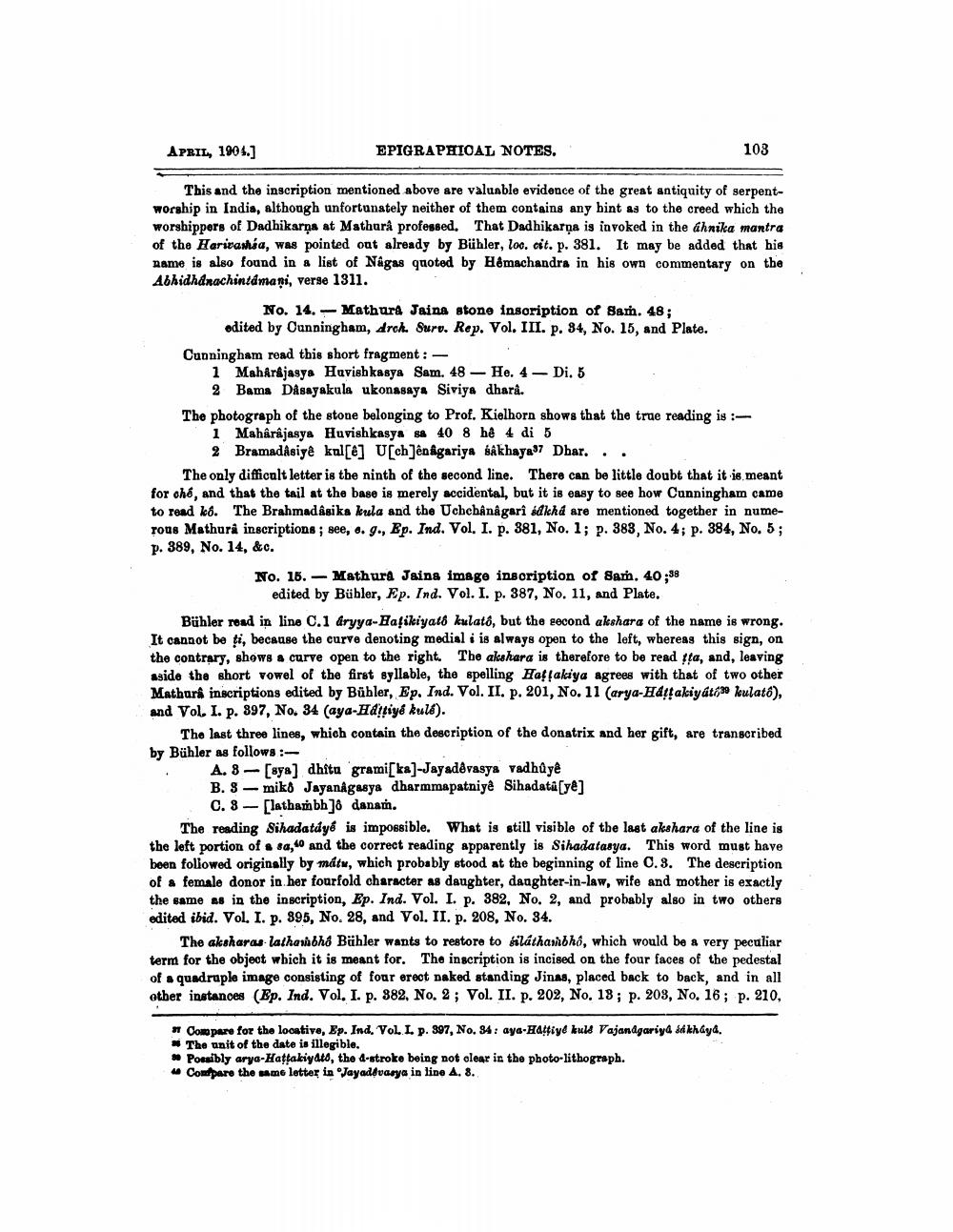________________
APRIL, 1904.)
EPIGRAPHICAL NOTES.
103
This and the inscription mentioned above are valuable evidence of the great antiquity of serpentworship in India, although unfortunately neither of them contains any hint as to the creed which the worshippers of Dadhikarņa at Matharâ professed. That Dadhikarņa is invoked in the ahnika mantra of the Harivashsa, was pointed out already by Bühler, loc. cit. p. 381. It may be added that his name is also found in a list of Nágas quoted by Hêmachandra in his own commentary on the Abhidhdnachintamani, verse 1311.
No. 14. -Mathura Jaina stone insoription of Sam. 48; odited by Cunningham, drol. Suro. Rep. Vol. III. p. 34, No. 15, and Plate. Cunningham read this short fragment :
1 Mahåråjasya Huvishkasya Sam. 48 - He. 4 - Di. 5
2 Bama Dåsayakula ukonasaya Siviya dhara. The photograph of the stone belonging to Prof. Kielhorn shows that the true reading is :
1 Mahârâjasya Huvishkasya sa 40 8 hê 4 di 5
2 Bramadasiyê kul[e] U[ch]ênågariya sakhaya? Dbar... The only difficult letter is the ninth of the second line. There can be little doubt that it is meant for che, and that the tail at the base is merely accidental, but it is easy to see how Cunningham came to read ko. The Brahmadasika kula and the Uchchânågari sdkhd are mentioned together in numerous Mathura inscriptions ; see, e. 9., Ep. Ind. Vol. I. p. 381, No. 1; p. 383, No. 4, p. 384, No. 5; p. 389, No. 14, &c.
No. 18. Mathura Jaina image inscription of Sam. 40:38
edited by Bübler, Ep. Ind. Vol. I. p. 387, No. 11, and Plate. Bühler road in line C.1 áryya-Hafikiyatá kulato, but the second akshara of the name is wrong. It cannot be ti, because the curve denoting medial i is always open to the left, whereas this sign, on the contrary, shows a curve open to the right. The akshara is therefore to be read fta, and, leaving aside the short vowel of the first syllable, the spelling Hafakiya agrees with that of two other Mathura inscriptions edited by Būbler, Ep. Ind. Vol. II, p. 201, No. 11 (arya-Hartakiyátás kulató), and Vol. I. p. 897, No. 34 (aya-Hayriye kull).
The last three lines, which contain the description of the donatrix and her gift, are transcribed by Bühler as follows:
A. 8- [sya] dhitu grami[ka]-Jayadêvasya vadhûyê B. S- miks Jayanagasya dharmmapatniyê Sihadata[ye]
C. 8 - [lathambh]8 danan. The reading Sihadatdye is impossible. What is still visible of the last akshara of the line is the left portion of e sa, and the correct reading apparently is Sihadatasya. This word must have been followed originally by máte, which probably stood at the beginning of line 0. 3. The description of a female donor in her fourfold character as daughter, daughter-in-law, wife and mother is exactly the same as in the inscription, Ep. Ind. Vol. I. p. 382, No. 2, and probably also in two others edited ibid. Vol. I. p. 895, No. 28, and Vol. II. p. 208, No. 34.
The aksharau lathanabha Bühler wants to restore to filáthasabhi, which would be a very peculiar term for the object which it is meant for. The inscription is incised on the four faces of the pedestal of a quadruple image consisting of four erect naked standing Jinas, placed back to back, and in all other instances (Ep. Ind. Vol. I. p. 882, No. 2 ; Vol. II. p. 202, No. 18; p. 203, No. 16; p. 210,
- Compare for the locative, Ep. Ind. VOL. I. p. 397, No. 84: aya-Hattiyé kuld Vajandgariya sa kháyd.
The unit of the date is illegible, # Possibly arya-Hattakiyato, the d-stroke being not clear in the photo-lithograph.
Contpare the same letter in Jayadevasya in line 1. 8.




